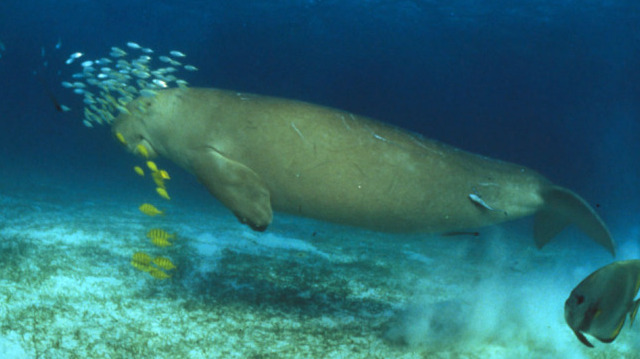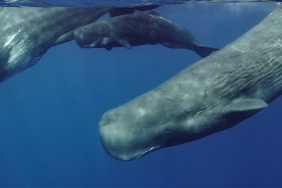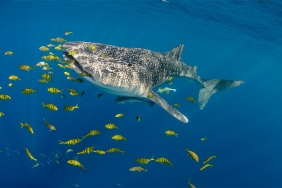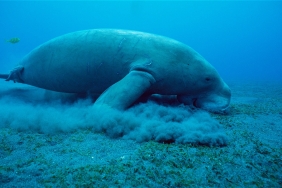DEATH OF BABY DUGONG IN TUINAN VILLAGE REMAINS A MYSTERY
By: Sheyka Nugrahani Fadela (Marine Species Conservation Assistant)
In late February, a baby dugong was found stranded on a beach in Tuinan Village, Buol Regency, Central Sulawesi. A number of villagers who knew about the incident took the initiative to care for the dugong, which was only about one meter long. This was conveyed to the staff of the Buol Regency Marine and Fisheries Service (DKP), who were also at the scene.
The animal, which was allegedly separated from its mother, had been cared for by a number of villagers for about two weeks before it was found motionless and declared dead in a pond made by residents on Friday morning (24/2). The death of the baby dugong in Tuinan Village was regretted by many parties, considering that the day before the death the animal was seen still moving actively.
The burial of the dugong carcass in Tuinan Village was carried out without necropsy, so the results of the analysis of the cause of death are limited to conjectures related to the quality of the place and the technique of caring for the baby dugong. Even so, the dugong stranding incident has been handled with quite good coordination, considering that various parties from the DKP of Central Sulawesi Province to one of the Technical Implementation Units (UPT) of the Ministry of Maritime Affairs and Fisheries (KKP) itself, namely the Makassar Coastal and Marine Resource Management Center (BPSPL), have assisted in rescue efforts and condition monitoring.
Members of the "National Stranded Marine Mammal Network" community spread across almost all provinces in Indonesia received information on the stranded baby dugong from A. Syahruddin, BPSPL Makassar. That way, the veterinarians who are members of the community can provide advice on the care of the baby dugong, although not through direct communication.
The first thing that came to the attention of the veterinarians from the physical condition of the baby dugong when it was first found was the presence of two wounds, namely on the abdomen and near the side fin (pectoral fin) on the body of the dugong. Based on literature analysis and the experience of several veterinarians who have been involved in handling stranded marine mammals, the wounds were suspected to be the result of a bite from a cookie-cutter shark. This type of wound is one of the most common on marine mammals, both stranded and still swimming in the open ocean. Prior to its discovery on the baby dugong in Tuinan Village, cookie-cutter shark bite wounds had also been found on a baby dugong stranded in Tanjung Benoa, Bali, and a juvenile dugong stranded on Kanawa Island, East Nusa Tenggara.
Deep bite wounds from cookie-cutter sharks generally expose the animal's insides to the outside, making infection more likely. In the case of baby dugongs in Tuinan Village, due to limited medical personnel and equipment, the wound can only be treated by applying antiseptic (betadine). The rest of the care for the baby mermaids is limited to providing nutritional intake in the form of rice and milk every day. Based on the advice of the veterinarians, the villagers moved the baby dugong from its temporary shelter, a canoe, into a 3 x 4 meter pool, 90 centimeters deep, made of tarpaulin and filled with seawater that is replaced every day.
According to Dwi Suprapti, National Coordinator for Marine Species WWF-Indonesia, there are several things that can be used as lessons for everyone from the stranding and death of baby mermaids in various places in Indonesia, including those in Tuinan Village. The most important thing is the need for veterinarians or experts in the field of veterinary medicine in handling strandings of dugongs and other marine mammals. These veterinarians or experts can assist first responders in making decisions regarding handling techniques and treatment of individuals that do require rehabilitation.
In addition to the type and characteristics of the wound on the dugong's body, the age of the individual is one of the important things to consider before taking action. Dugongs with a length of less than two meters are still classified as relatively young, or even babies. Individuals in this age range are still very sensitive to the technique and quality of treatment provided by stranding responders or nurses at the place where the individual dugong is rehabilitated. Especially for baby mermaids, the nutritional intake provided should be in accordance with the intake usually provided by the mother mermaid. In this case, the intake can be in the form of milk with certain compounds.
If young dugongs or baby dugongs are to be rehabilitated, the quality of the rehabilitation facility must be highly considered. Poor water quality in artificial ponds, for example, can aggravate infections in wounds that have been present since the dugong was stranded. Other problems, such as increased physical stress (stress), are also difficult to avoid if the quality of rehabilitation facilities is poor.
One of the goals of rehabilitation is for individuals to be returned to their natural habitat. In the case of baby dugongs, it is important to locate the mother in the vicinity of the stranding site. Ideally, the release of the baby mermaid to the sea is done after information about the mother's whereabouts is known. This is because the individual baby is still very dependent on its mother, especially in terms of protection and foraging.
The death of the baby dugong in Tuinan Village was sad, but some aspects of the handling inspired many people to do better and have high hopes for the handling of marine mammals in the future. One of the hopes expressed by Dwi, for example, is for an official "flying vet" (veterinarian on standby) who can be deployed anytime, anywhere, along with an allocation of emergency funds, in the event of a stranded marine mammal with high life expectancy. These veterinarians are expected to have full authority to carry out their duties, so that treatment can be carried out appropriately and quickly. Another expectation from Dwi is a special rehabilitation center for small marine mammals, less than five meters in size. This facility could be equipped with specialized veterinary nurses if there are marine mammals that require long-term treatment.
Note to Editor:
Dugong (Dugong dugon) or dugong is one of 35 marine mammal species found scattered in Indonesian waters, and has been designated as one of the MPA's 20 priority target species for protection. Dugongs are marine mammals protected by the government through Law No.5 of 1990 and Government Regulation No. 7 of 1999. These mammals, which can reach three meters in length, consume seagrass and play an important role in the marine ecosystem. Internationally, dugongs are included in the IUCN (the International Union on Conservation of Nature) Red List as "vulnerable to extinction" (Vulnerable) and included in Appendix I of CITES (the Convention on International Trade in Endangered Species of Wild Fauna and Flora), so trade in dugongs and their body parts in any form is not permitted.





